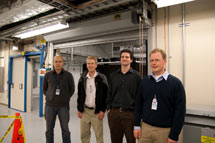
Handy Links
SLAC News Center
SLAC Today
- Subscribe
- Archives: Feb 2006-May 20, 2011
- Archives: May 23, 2011 and later
- Submit Feedback or Story Ideas
- About SLAC Today
SLAC News
Lab News
- Interactions
- Lightsources.org
- ILC NewsLine
- Int'l Science Grid This Week
- Fermilab Today
- Berkeley Lab News
- @brookhaven TODAY
- DOE Pulse
- CERN Courier
- DESY inForm
- US / LHC
SLAC Links
- Emergency
- Safety
- Policy Repository
- Site Entry Form

- Site Maps
- M & O Review
- Computing Status & Calendar
- SLAC Colloquium
- SLACspeak
- SLACspace
- SLAC Logo
- Café Menu
- Flea Market
- Web E-mail
- Marguerite Shuttle
- Discount Commuter Passes
-
Award Reporting Form
- SPIRES
- SciDoc
- Activity Groups
- Library
Stanford
Around the Bay
Preparing for LCLS Soft X-ray Science
The finish line for the Linac Coherent Light Source's Soft X-ray Materials Research instrument is barreling into view. In a few short months, the SXR should be in position to host user groups for a variety of different experiments, from surface chemistry to magnetic ordering to superconductivity and beyond.
The SXR uses longer "soft" wavelength X-ray bursts from the LCLS. Soft X-rays allow researchers to study specific elements, such as cobalt, iron and oxygen. The low energy of the soft X-rays will, quite literally, only scratch the surface, but in this instance, scientists are most interested in the exterior, superficial properties of their materials.
SXR Beamline Engineer Michael Rowen highlighted the speed at which the SXR project came to fruition, meeting both a tight timeline and budget.
"Things have really come together well," he said. "We've been pushing hard."
One of the last of the six LCLS instruments to begin development, but only the second slated to start running, the SXR has undergone a fluid and rapid transformation since the fall.
"We know what's going on with every side of this," said Bill Schlotter, one of two SXR instrument scientists. He coordinates among user groups, technicians and engineers to get the SXR ready for its scheduled May 6 launch. Currently, they have nine teams of users lined up for 60-hour windows of SXR time this spring.
The SXR beamline is unique with respect to the LCLS's other beamlines because it was designed for scientists to bring in their own equipment. The experimental hutch is nearly empty to accommodate scientists rolling their own devices in and out.
"We can do chemistry one week, physics the next," said Josh Turner, who recently joined SLAC as the second SXR instrument scientist.
This gives the SXR great flexibility in terms of user options, but also presents challenges for the instrument scientists. Preparing for a diverse set of experiments and transporting equipment from around the world require extra layers of organization. For every experiment, Schlotter and Turner need to make sure that the users have their samples and chambers ready, in addition to providing compatible power supplies and motors. Fortunately, they have the help of many other people around SLAC for these tasks.
Schlotter is particularly excited about the recent completion of the SXR control room, which he calls "definitely the most glamorous" aspect of the instrument.
"The control room is important because it is the interface between the users and their experimental equipment," he said. While running samples on the SXR beamline, scientists can remotely adjust and fine-tune the mirrors and detectors using the control systems developed at SLAC. The walls of the control room are lined with large computer monitors, ensuring that scientists can see every control system and every last smidgen of data pouring in.
In addition to the completion of this flashy new control room, the team recently received the SXR monochromator. Built in Germany in a break-neck seven months, this instrument will give users better control over their experiments by allowing them to choose and fine-tune the X-ray wavelength. Finally, all the SXR mirrors are newly coated with boron carbide to guard against heat damage from the intense LCLS X-ray pulses.
Schlotter and Turner anticipate their day-to-day routines will shift dramatically after commissioning of the SXR begins in May, and again when user groups show up in June. Right now, they are still ordering parts and helping the user groups plan for their brief, 60-hour slots of SXR beamtime. Soon, they will be spending a lot more time in the control room and experimental hutch, tweaking and tuning the instruments.
"We're getting to know where our priorities sit," Schlotter said. "Our job will totally change once the experiments start."
óJulie Karceski
SLAC Today, March 2, 2010
